Mighty Avengers #1 (Marvel, $3.99) 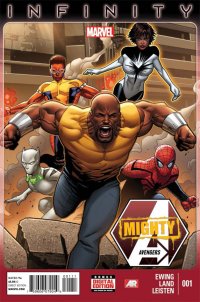
By Graig Kent
Let’s start by addressing the elephant in the room by pointing out that many people are calling this new iteration of Mighty Avengers “the Black Avengers” (or they avoid calling it that directly but in roundabout ways say the same damn thing) due to the majority of its cast being African-American. I should also point out that it’s at once reductive called it that, and also somewhat on-the-nose, if only in its design by Marvel.
Unfortunately having a predominantly black roster is going to be a detraction for a lot of comics readers and comic shop owners, much in the same way that Milestone comics were also being maligned as “black comics” back in the day and underordered (or not ordered at all — if it weren’t for having them on my pull list I would have never caught most of them) and definitely under-promoted by publishers, fans and the comics community. The misconception for some reason is that these are not simply “comics” but “comics for a targeted audience”. It’s something that some white kids (by kids I mean Dan Didio’s 40-year-old-manchild target audience) say “oh, this isn’t meant for me” and that so many others say “this feels too deliberate, too phony and inauthentic to be worthwhile”. News sites aren’t helping with that perception, qualifying Mighty Avengers in their headlines as “black-focused”, which perpetuates the perception as “these are comics only for black people”. Marvel isn’t helping by making the “Mighty” part of their logo a spraypainted tag, because, you know, these Avengers are from the street.
There’s a long-ago identified, often-commented-upon inherent bias, if not outright racist attitude within the industry against non-white, non-male protagonists. The proto-feminist comics movement is starting to reap rewards, with more female characters headlining their own series, more female writers and artists cropping up in more prominent titles. But the same can’t be said for black characters or creators. I can’t think of a single active writer at the Big Two who is black. And just how many black characters are headlining their own titles?
The perception as always is that titles starring strong, empowered women and minorities don’t sell, but it’s almost always a self-fulfilling prophecy. The mainstream publishers generally don’t put the talent, the promotion, or their full support behind these books, or if they do, and they don’t reap instant rewards, they give up too easily. Of late Bendis’ Ultimate Spider-Man, DeConnick’s Captain Marvel, and Azzarello and Chiang’s Wonder Woman have all been prominent success stories breaking this rule, and there have been some other exceptions here and there, but for the most part, DC and Marvel put the barest of efforts into these books and use their failures as excuses not to try it again.
Mighty Avengers, I’ll grant you is a different case, in that Marvel has been doing some heavy promotions and focused marketing at the comic blogs and news sites, and plenty of retailer incentives, as well as tying Mighty Avengers into the massively popular Infinity event. It does look like they’re putting some weight behind it. But at the same time, it still reeks so heavily of tokenism, of “look what we’ve done, praise us for being progressive”, by top-loading their book with an African-American cast. Some could say this is extreme over-compensating. I know I did, and I’ll admit to having that knee-jerk reaction of “this is too deliberate”.
But the conversation of race put aside for the moment, after reading the book, it struck me as quite the opposite of deliberate. Marvel’s design may have been “a black-focused Avengers” but, in context of the story and characters, writer Al Ewing deserves a lot of credit for not making race a conceit. He takes Luke Cage, ex-leader of the Avengers and the Thunderbolts and puts him back in his familiar element with Heroes For Hire. There he’s mentoring the young Power Man, who wields the chi of New York, and leading White Tiger into fights with loser criminals. This draws the attention of the pedantic and patronizing Superior Spider-Man. Hostilities ensue and Spidey calls into question their true heroic nature if the job is not its own reward. This leads to Luke rethinking his time at H4H and his status as an Avenger, causing conflicts with his immediate teammates. Monica Rambeau, ex-Captain Marvel, now called Spectrum (bleh) is introduced with flare and a smile and testing a new costume (shades of The Incredibles here). She’s just vibrant and charming, Ewing’s stated affection for the character is evident. Then there’s the mysterious and ridiculous “Spiderhero” who well, is another hero in disguise as part of an already annoying sub-plot. So on their own merits, each of these characters is unique, intriguing (minus Spiderhero) and Ewing establishes a uneasy, fun dynamic between them all, without race ever coming into it. That they are in a book together suddenly doesn’t seem so contrived. Instead, the contrived part is the middling tie-in to Infinity that bookends the first issue.
I never like having a new series start as a cross-over to an event. While it may draw immediate attention and a potentially larger audience to the book initially, it does the creative team a great disservice by putting the focus towards tying in the event instead of building the book’s natural rhythm and flow. Instead of taking a few months to find its feet and get the ball rolling on its ongoing story elements and character beats, it takes probably twice as long as the introductory story is eaten into by another story entirely. Ewing’s doing what he can here, but I get the sense it wasn’t his idea to launch the book this way. It serves as the impetus for gathering the team together (an alien invasion, looking back to Whedon’s Avengers or the Ultimates once more), but it doesn’t feel organic in any way.
As a result of being a tie-in, the first issue is a challenging starting place for readers not reading Infinity (I’m trade waiting). As such the opening story page setting up the Infinity tie-in was dry and bordering on nonsensical. Equally, knowing that Big Events are rarely ever “fun” in tone, it’s a stark contrast to the tone Ewing wants to set for the book. Mighty Avengers takes the attitude of a buddy cop film, with lots of snappy, quibbling dialogue and provides a pair of ludicrous villains (Plunder and Blue Streak) to take on. We’re not at Giffen-DeMatteis Justice League off-the-wall comedy here, but heading more towards the feel of Joss Whedon pithy ensemble territory. Ewing establishes this tone well, but again the Event-related stuff just impedes on it direly.
Though Marvel seem to have the best of intentions with this book, it still comes off as a slight effort, like they’re not really looking all that hard to make it a success. I mean Ewing does solid work on the book, surprisingly so for a guy I’m not at all familiar with. I do like what he’s doing (Power Man delivers a laugh-out-loud rebuttal to Spider-Man early on that’s a classic in my book), but it doesn’t feel like an Avengers book should feel, certainly not if we’re talking the movie as a benchmark, which we should. It doesn’t feel big or even necessary. As well, in terms of name recognition, Ewing is a virtual nobody on these shores (having done most of his work on UK titles), so you add “unknown writer” to “perceived tokenism”, “yet another Avengers title” and “flagrant Event tie-in” and it’s just a chromium cover away from being dismissed entirely on principle.
And then there’s Greg Land, a polarizing Liefeldian superstar artist through and through. You either love him or he’s a punchline. His reputation as a reference-based illustrator has left many to question his artistic validity, while others like their superheros looking like celebrities or models and don’t desire facial consistency. I admit that Land’s work overall is pretty nice to look at, his feathery lines and composition style are on the level of a Terry Dodson or Stuart Immonen, He draws sets and figures exceptionally well, but it is that pesky tendency towards photo-referencing that sinks him for me every time. Here, it would seem, that Luke Cage is being played by Terry Crewes (at least 50% of the time) and I think Monica Rambeau is at least four different actresses or models throughout the book (is that Whitney Houston in one panel?).
Early word is that the book has been under-ordered by retailers, surprising absolutely no one, and it’s got a hard struggle ahead of it in finding an unbiased audience in an overcrowded marketplace. I honestly believe were this a Heroes-For-Hire or even Luke Cage or Power Man solo book that there would be less scrutiny and next to no conversation about race surrounding the title, though also likely no more successful. I think Luke Cage has evolved beyond the “Sweet Christmas” blacksploitation origins and become a central figure for the Marvel Universe, one who earned a team lead and even his own title without needing Spider-Man to back him up. There’s the best of intentions with Mighty Avengers, and some talent to back it up, but not the right next-level talent to both overcome any ingrained prejudices (if this were, say Warren Ellis and Mike Deodato Jr, I don’t think we’d be having the same conversation) and elevate the status of yet another Avengers series.
Rating: 




Out of a Possible 5 Stars
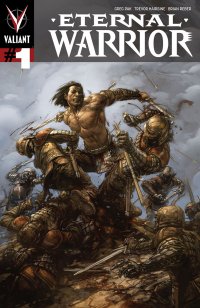 Eternal Warrior #1 ($3.99, Valiant)
Eternal Warrior #1 ($3.99, Valiant)by D.S. Randlett (@dsrandlett)
In its original iteration, Eternal Warrior was one of those derivative concepts that managed to take on a sense of pathos and drama despite itself thanks to (a) the talent involved, and (b) some twists on the concepts that it was aping. Gilad Anni-Pada was one of three immortal brothers (each very different) from Mesopotamia. At his base, he was a riff on two of the most popular genre properties at the time: The Highlander and The Terminator (the “protect John Connor” model). He had the history aspect, and the undying loyalty to a teenage boy to go with his (even then) ridiculous biker iconography. The teenage boy wasn’t just any kid, though, he was the Geomancer, an avatar of the planet. The relationship between Gilad and Geoff really elevated the concept. Gilad wasn’t programmed to protect the kid, but he had sworn himself to protect the Geomancers because he felt it made him more than a killer. At its root, Eternal Warrior could take those nineties action film touchstones and weave them around a character who had more in common with someone like Unforgiven’s William Munny than with someone like Rambo.
The new Eternal Warrior made his debut, along with an all new and very different Geomancer, in in Fred Van Lente’s superb Archer and Armstrong. Van Lente demonstrated a real command over what made the character work by providing an origin story full of bloodlust and redemption in the past, while sending up his nineties roots. Gilad’s appearances often felt too brief because they could be funny, dramatic, and just plain awesome all at once. So, to fill that gap, we have a new series from Greg Pak and Trevor Hairsine.
Most of Valiant’s output has had a somewhat satirical bent, thanks to writers like Joshua Dysart and Fred Van Lente injecting titles like Harbinger and Archer & Armstrong with a jaundiced view of up to the minute events. Pak’s approach takes a different tack by taking the “Eternal” part very seriously. The issue begins with a scene set in an ancient past resembling something out of a Conan book. Gilad is leading a charge of his kinsmen against a horde of hulked/roided out cultists who mean to do grievous harm to them, along with their women and children. And then we’re thrust into the present day, where Gilad is enjoying one final day of peace and quiet (this apparently takes place before his appearance in Archer and Armstrong) before the past comes knocking on the door of his secluded cabin.
There are twists, turns, and tragedy in these twenty two pages, none of it particularly mind blowing or original. However, Pak sets a good precedent and stakes out some solid thematic ground. Where the rest of the line has taken on a tone of up to the minute comment, Pak makes Gilad a man consumed by his endless time, and the ceaseless call to war. Instead of satire and the breathless pace of a bantery action movie, Pak looks to epic fantasy and Westerns for tonal inspiration. Not to say that this issue is slow, as a lot does happen, but at the Valiant party, Eternal Warrior seeks to be the guy who comes in every now and then with a wise and incisive comment rather than a barrage of witty ones.
Trevor Hairsine’s art echoes Pak’s different tones in each phase of the story, and is appealing on its own merits. The epic fantasy beginning is frenetic, bloody, and chaotic. The evil marauding warriors looking to conquer Gilad’s tribe are suitably imposing, and rush toward the reader in a few extremely evocative panels. Later, Hairsine and colorist Brian Reber evoke Gilad’s isolation and his Munny-like desire to leave everything behind, with a little bit of horror thrown in for good measure.
While the first issue doesn’t blow the doors off, it does introduce us to a different kind of superhero series in a different kind of superhero line. I keep being surprised by the quality of Valiant’s output, which really is a lesson in everything the New 52 should have been, but I suppose it’s about time to start taking it for granted. Like much else of the company’s output as of late, Eternal Warrior is worth your time.
Rating: 




Out of a Possible 5 Stars
Deadpool #16 (Marvel, $2.99)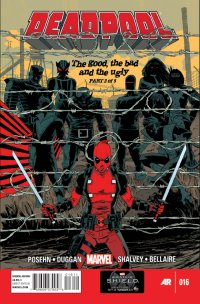
By Adam X. Smith
I’m of the opinion that misfits make the best heroes. No-one gives a shit about the trials and tribulations of a well-adjusted hero who comes by his powers and back-story through happy accident of birth or lucky coincidence; we like our heroes to be angsty and mishap-prone, the old wisdom goes, because that’s how we see ourselves: the eternal butt-monkey of society – nay, the Gods and fate themselves – until the fateful day of our heroic awakening.
Thing is, what happens when the misfits become the popular ones? Worse, what happens when the misfit-popular clique becomes disproportionately filled with brawny, joyless, steroidal arseholes?
The enduring popularity of Deadpool, then, clearly sends the following message: when there’s no more room in the X-Mansion for all the swishy glamour models and roided-up juggernauts, pastiche will always keep stagnation at bay. Either that or outright parody and jokes about tits.
The thing that allows the current creative team behind the Merc with the Mouth to rise above the dreck turns out to be the decision to hire an actual comedian, Brian Posehn, to be a co-writer on the book; whilst this might seem like a no-brainer to those who’ve seen his work, I’m forced to remind you all that John Cleese was a co-writer of the god-awful Superman: True Brit.
Nevertheless, the team of Posehn and Gerry Duggan has done excellent work throughout the Marvel NOW! rebranding to keep Deadpool’s antics both funny and relevant at the expense of neither. And whilst the lapse into Spider-Man-esque “team-up of the week” episodes of recent issues did lose me a little, the promise of a new story-driven arc with the title “The Good, The Bad and The Ugly”, which appears to be trading heavily on the presence of teaming-up with not just fellow Weapon X mainstay Wolverine but big blue Boy Scout Steve Rogers as well (try to guess who is who), proved too irresistible an opportunity to jump back on the bandwagon, drink the Kool-Aid and have my cake and eat it too.
Picking up directly from part 1, Wade has ended up captured by former Weapon Plus scientist Butler, who bears more than a slight resemblance to a certain chemistry teacher turned drug manufacturer, who has been secretly harvesting Deadpool’s organs for years and wiping his memory in a bid to replicate the process that both cured Wade’s cancer and gave him his powers; the reason turns out not only to be to cure his sister, who appeared last time in a cryogenic tank Nora Fries-style, but as a contract for a certain elderly general named Jong with a fondness for Hawaiian shirts. That’s right, folks – Weapon X has a facility in North Korea, and it only gets weirder from there.
Without spoiling it for those unfamiliar with the character, let’s just say that considering the first arc Duggan and Posehn wrote for this book involved Deadpool going all Ghostbusters on the resurrected souls of dead US Presidents, they’ve done a hell of a job giving him pathos and humanity, to the point of re-evaluating the way we look at a man who is technically as much a victim of Weapon X as anyone else, yet always seems to be the comic relief. The concept of Wade’s madness not simply being because of the original experimentation on him, or the underlying mental health problems he had long before that, but in fact the result of the military-industrial complex tampering with his body and mind long after his usefulness to them would seem to have ended, is the stuff of heady conspiracy thrillers, not a rambling, scatological, jumped-up breakout character from The New Mutants. And the revelation that his DNA is the key to combining the X-gene with ordinary people (at the cost of looking like a burn victim) raises more questions – why Butler would allow Deadpool to remain “free range” for so long when he was dependant on his genetic material being high on that list.
But you know what? It’s good. I’d even go so far as to say it’s very good. We get misshapen Korean X-clones, Wade’s mental co-habitant Agent Preston (it’s all in the prologue, don’t worry) gets something to do besides being a voice in his head when Butler causes Wade to experience a Heroic Blue Screen of Death (look it up), the taste of Wolverine and Cap we got last time turns out to not be a one-and-done appearance after all, and most importantly, we get to see Wade be a genuine badass. Not just by the usually Jack Sparrow “is he just making it up” standards his world seems to run on -Wade actually does a fair amount of ass-kickery in this book, and almost entirely without a shred of his usual wackiness.
On top of that, the new artist Declan Shalvey works well with the fine balance between humour and grit that the aforementioned arc title invokes. This is a definite “buy” recommendation, on the proviso that you back-order #15 if you haven’t already. Whenever I have my doubts about the whole Marvel NOW! rebrand, I’m reminded of this book and then I realise it’s not all bad after all.
Rating: 




Out of a Possible 5 Stars
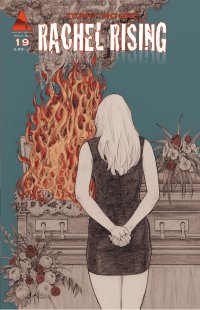 Rachel Rising #19 (Abstract Studios, $3.99)
Rachel Rising #19 (Abstract Studios, $3.99)
Rachel Rising Volume 1: The Shadow of Death (Abstract Studios, $9.98)
By Jeb D.
Every now and then, as I start to decide which comics I’m going to review for the week’s column, I remember that I’ve not yet covered a book which I regard as one of the half-dozen or so best comics being published today: Terry Moore’s Rachel Rising. I pick up the latest issue, devour it, then go back again and savor it… and then I remember why I’ve never reviewed it.
Rachel Rising, as you may have heard, is a horror book; it is that, and at times a cruelly black one. It’s also a mystery, nicely layered, and full of nuance. Given that this is Terry Moore, it’s a well-observed series of character studies, with a strong, largely-female, cast. And it’s often pretty funny.
But it’s not a book that lends itself to single-issue reading: not that any given issue won’t be satisfying, but even more so than most comics, full enjoyment of any one issue depends on having absorbed the story to that point. The mystery reveals some new aspect nearly every issue, shedding new perspective on preceding events.
Given the numbering, I thought this might be different. Last month’s issue #18, I presume, will fill out the next trade collection, so issue 19 would start off a new phase in the story, if not precisely a new “story arc,” giving me the chance to recommend this to new readers.
And, in fact, this issue is something of a departure: a more or less self-contained historical piece, tightly plotted and well characterized; even the fact that one of the characters is familiar to regular readers of the series wouldn’t leave the new reader lost. They would, though, lose the resonance of recognition, and sensing how this short piece fits into the whole. And then, on the final page, Moore peels back yet another layer of the book’s central mystery, and I realize that the task is hopeless: Rachel Rising demands to be read from the beginning (Moore pretty much acknowledges this by refusing to include even a paragraph of recap at the beginning of each issue), with the new reader coming fresh to the story.
For all that Rachel Rising is an effective, often disturbing piece of storytelling, it’s anchored in Moore’s familiar 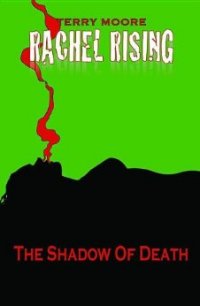 strengths. The characterizations are as deft as ever, and he writes women as few male writers do: never defined simply by their gender, but not the “male character drawn as a woman” common in too many comics; it’s a particularly impressive feat when you consider that, back when he was coming up with Strangers In Paradise, his decision to write about female characters was driven largely by the fact that he enjoyed drawing women more than men. The dark, disturbing environment of Rachel Rising makes the best use yet of Moore’s stark expertise with the black and white palette.
strengths. The characterizations are as deft as ever, and he writes women as few male writers do: never defined simply by their gender, but not the “male character drawn as a woman” common in too many comics; it’s a particularly impressive feat when you consider that, back when he was coming up with Strangers In Paradise, his decision to write about female characters was driven largely by the fact that he enjoyed drawing women more than men. The dark, disturbing environment of Rachel Rising makes the best use yet of Moore’s stark expertise with the black and white palette.
Some readers of Strangers In Paradise were reluctant to follow Moore’s first full-scale foray into the world of sci-fi and superheroes (he did illustrate a terrific Spidey-Black Widow adventure in the old Ultimate Team-Up book) with Echo, but that series demonstrated how much he’d grown as a storyteller: SIP was always engaging, even when it frequently meandered here and there; Echo, on the other hand, was a tight, well-plotted story that hit its mark in thirty issues, with just as much heart and humor. My only real concern about Rachel Rising has been Moore’s (evidently belated) decision to make it an ongoing, rather than fixing an endpoint yet; it’s not the kind of story that I can see working in a completely open-ended fashion. Up to this point, though, it’s as gripping and memorable a reading experience as I can recall in a book of this type, and I’m willing to stick it out as long as Moore can keep finding new ways for his story to amaze, and appall, me. For new readers, though, that first trade collection, at just ten bucks, is a complete steal.
Rachel Rising #19: Rating: 




Out of a Possible 5 Stars
Rachel Rising Volume 1: Rating: 




Out of a Possible 5 Stars
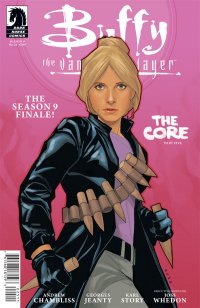 Buffy the Vampire Slayer: Season 9 #25 (Dark Horse, $2.99)
Buffy the Vampire Slayer: Season 9 #25 (Dark Horse, $2.99)
by Graig Kent
After I binge on a TV show I loved or following a movie I enjoyed, I tend to go through phases immediately thereafter where I want to consume everything peripheral to them. For instance, after watching Oz: The Great and Powerful, I went back and watched Return to Oz and bought Muppet Wizard of Oz for the kids, and then steadily started buying up Hardcovers of all the Marvel adaptations of Baum’s books as well as IDW’s collected editions of Eric Shanower’s great 90’s Oz continuations. But that fervor of enthusiasm lasted about a month and a half before I burned out, or got distracted, or both. There’s a lot of unread Oz stuff by my bed.
Similarly, two-ish years ago, after binging on the Season 7 of Buffy for the first time and then diving into 3 unwatched seasons of Angel I had the urge to backtrack and gorge on the troubled Buffy Season 8, the timing of which managed to segue straight into the release of Buffy Season 9 and the Angel & Faith “season”. I was initially excited for more Buffy and Angel, but, as this was at the same time as the New 52, of which I was both curious about and fervently binging on, the Buffyverse was working hard to hold my attention. I gave up on Angel and Faith after the first year, not because it was bad, but because of Comic Consumption Fatigue (CCF), a never-before-identified, but all-too-common condition experienced by rabid consumers of comic books after reading and being disappointed by far too many comics and feeling the pocket-book pangs of regret. Fact of the matter is, I was enjoying Angel and Faith more than Buffy, but I deemed Buffy to be the “more important book” of the two.
By issue 18, though, and a few abandoned starts with each of the Spike and Willow mini-series, I wanted to give up on the Buffyverse altogether. It just wasn’t working for me, but I forged on, hoping it would connect. We’ve now hit the final issue of the season and I still can’t resolve why my enthusiasm has waned so, but I’ve derived very little pleasure out of this series, and my investment in the characters has been fairly low. I liked some conceptual ideas, like the the council of remaining magical beings, including Illyria’s return, and even in concept Billy the Vampire Slayer. But other elements, like the rehash of Spike and Buffy’s romance, the bewildering Xander/Dawn relationship, Spike losing his alien bug ensemble (only the best post-TV addition to the Buffyverse, and it’s now gone) and the whole quest to return to status quo by reverting the events of Season 8 all struck me as looking backwards to move forward. By the end of Season 9 there are hints of a brand new world to move forward into, but we just had a brand new world at the beginning of this season, and everyone hated it (speaking for the characters here) and longed for the old one.
The final arc, “The Core” found Dawn fading away from existence as the remaining magics on Earth started to ebb…or something. Severin has stolen too much power and can’t contain it, and partnered with Ex-Slayer and Buffy-hater Simone, they had turned Xander to their side promising Dawn’s salvation. Things have all come to a head, and they conclude here, and it’s all a big spectacle as Buffy and team square off against their foes, including the vampire creator Maloker, a garganuan bat demon loosed by Simone. Georges Jeanty handles the visual component impeccably well, and with Karl Story on inks, his work is actually at his best right here. Some of the panels involving Maloker work so well at showing his size relative to the other characters, often using the panel’s depth to do so.
Working less well is Andrew Chambliss’ script which struggles to keep the punchy Whedon-esque dialogue going while all these balls are in play. It’s a busy, busy sequence and the sheer level of dialogue happening overwhelms the action. Even the epilogue and postscript seem uncertain as to where to leave the universe and the characters. I don’t recall there being many happy endings at the end of Buffy seasons, so this once more feels out of step with the usual Buffy season finale.
It’s evident that I’m not a super-fan of the Buffyverse, though I do like it a lot, and I appreciate the level of storytelling craft Whedon and company put into the show while it was on the air. I also never undervalue the importance of Buffy as powerful and necessary pop-culture icon. The comics, however, struggle to live up to that model because, for the most part, it’s not the same thing as television. Despite Season 8’s weirdness, it felt more like what a Buffy comic book should be, bigger and more eventful. Season 9 has been intentionally reserved to fit in more with the general show aesthetic but, in doing so, it doesn’t stand out as much on a very active comic book rack.
Buffy #25: Rating: 




Out of a Possible 5 Stars
Buffy Season 9 Overall: Rating:





Out of a Possible 5 Stars
Tall Tales from the Badlands (Black Jack Press, $2.50)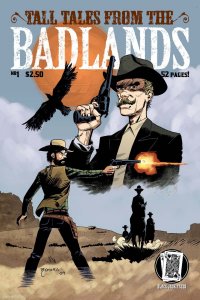
By Adam X. Smith
It occurred to me this morning that I don’t dislike Westerns particularly – indeed there are quite a few I can honestly say I like very much – and yet with the exception of things like Preacher and Serenity – which stretch the definition as Westerns, to be sure, but still utilise a lot of the tropes – I can’t really think of any Western-themed comics I like. It’s certainly not based on any inherent bias, but if pressed I’d say my main gripe with them is that they’re always dressing the Western side of it up as something else, like they’re embarrassed by it, as opposed to just letting Westerns be Westerns.
Maybe I’d care for the likes of Jonah Hex, Bat Lash, Vigilante and the Lone Ranger a lot more if they were given more to do in the canon without having to be flung forwards and backwards in time and space by this week’s plot MacGuffin or rebranded as a leather and spandex-wearing gimp to fit in with the capes and masks crowd, or if their principle nemeses weren’t always a samey procession of supernatural bogeymen like vampires, werewolves, aliens or – God help us all – Wild Wild West-style steampunk monstrosities. This sort of cultural cringe – where people like to mythologise the past in their imaginations, but in practice find the results somewhat underwhelming – hasn’t seemed to prevent the pirate, noir or war genres from becoming stale, so naturally the Western shouldn’t be the exception.
So where does this leave Tall Tales from the Badlands? Well, it’s a black and white small-press Western-themed anthology comic written by Sean and Seamus Fahey (yes, they’re related)* and art by Lissandro Estherren, Jose Holder, J.C. Grande, Juan Romera and Borja Pena – it’s not exactly Jupiter aligning with Mars to bring a new age of peace and love, but for $2.50 (my review copy was free) you can do a hell of a lot worse.
If I was to pick a major fault with the book – and as reviewer it’s my job to – I’d say it’s one of consistency of quality, both in terms of the stories being told and the art used to portray them. Early stories such as Sean and Lissandro’s “Thicker Than Water” and Seamus and Jose’s “Abigail” in particular suffer the most from art that doesn’t quite pass muster – Lissandro’s bold attempt to mirror the Mike Mignola style of light and shade doesn’t quite stick the landing – and a tendency to introduce elements that don’t always serve the narrative or prove to be dead ends, which in a story that’s 12-14 pages long feels a little like either an extravagance or something that could have gotten whittled out.
However, Seamus and Juan’s “A Thousand Deaths” and Sean and Borja’s “Easy Livin’” find just the right balance of great artistry and writing, choosing as they do to follow two very different lone-wolf protagonists on their way through the West: one a seasoned gunslinger (or is he…?) and the other a trapper trying to make his way in the ever-shrinking wilderness of the frontier with only a bottle, a rifle and his trusty mutt for company.
At the end of the day, though, is it good? Yes, pretty much. You get what it says on the tin. There are better made, better presented Western comics, to be sure, but I’m not reading them, am I? I’m reading this one, and you know what? This reads like the product of someone wanting to fill the gap in the market for those who’d like this sort of thing. And even if I’d be lying if I said that Tall Tales fits me like a glove, I can’t hold a grudge against something that so ardently wants to fly its flag, and still believes in taking risks and living the dream. Now if you’ll excuse me, I’m going to go listen to “Wild West Hero” by Electric Light Orchestra.
*Full disclosure: Sean Fahey was the founder of Thor’s Comic Column; however, since his tenure here is well before my time, and I don’t know him personally, I assure you no cheap favouritism will be on the cards. I’m not in this business to sell out, you know?
Rating: 




Out of a Possible 5 Stars
And now, an open letter to DC Comics, from Mr. Adam X. Smith…
Whilst I do not wish to drag my contribution to Thor’s Comic Column into editorialising any more than I already have, I feel that I have to say something, however brief, about the recent debacle at DC concerning the revelation of J.H. Williams III and W. Haden Blackman’s resignation from Batwoman and the unfolding drama over the Harley Quinn ‘sexy suicide’ talent contest.
The official statement from DC in response to the Batwoman fiasco has been to distance themselves from any anti-LGBT bias firstly and then to explain that their decision was based on the notion currently held by the company that they do not wish for Kate Kane aka Batwoman to marry her fiancé Maggie Sawyer because “none of their characters are allowed to be happy”.
Flimsy as this excuse is, and even if we ignore the fact that the decision for the two to marry was planned months in advance to little controversy from DC and was, like several other story arcs, spiked at the last minute, it hardly accounts for the decision that Superman and Wonder Woman, two of the companies’ flagship characters, becoming an item is somehow an event worthy of pomp and publicity, whilst Batwoman, whose popularity is the result of genuine fan interest and hard-won struggles by creative teams, has had her entire run at DC compromised by editorial interference to such a degree that it has resulted in not only Williams and Blackman quitting the book, but in co-creator Greg Rucka being permanently estranged from the company and the original artist on the title leaving before the book had even been released due to “creative differences”.
Nor does it explain or justify the abrupt shift in the characterisation of Harley Quinn from a childlike, cartoonish female sidekick to the Joker whose sexuality when present was always implicit and naïve, to a heavily sexualised, frequently victimised damsel stereotype defined through her relationships to men, and certainly doesn’t explain the recent talent contest’s unhealthy decision to fetishize her as a self-harming masochist and a figure of mocking derision. DC has remained largely silent on that front, perhaps in the knowledge that there is no way of spinning this particular faux pas in their favour, perhaps in the knowledge that Harley is not the only female character being disproportionately mangled and mishandled by them.
Last week on the column, reviewing the exceptional Batman Black and White #1, I said that I would happily settle for a retread of the ‘90s Bruce Timm iteration of Harley Quinn, with all the good and bad that would entail, than accept whatever DC were currently passing off as Harley Quinn comics, with the continuing noxious trend of demeaning sexual and physical exploitation of the character in the name of so called “fanservice”. The week before that, reviewing the mediocre-by-comparison Batman Incorporated Special, I said that we, the public, don’t want or need to keep redefining Batman or copy-pasting him across the world in the form of international expies – we just need better Batman comics, full stop.
I will reinforce and rearticulate that statement now: we not only need better Batman comics; before that, we need a better DC Comics. One that respects the desires of the creators that they pay to write and illustrate stories for them, that doesn’t ambush them with editorial bullshit at the tail-end of the publication pipeline but works with them throughout to ensure we get the entertainment we deserve, and most importantly one that answers for its failure to meet the standard we as consumers should all hold them to.
Since the 1950s and the days of Mort Weisinger, DC has had a habit of employing fetishistically strict, almost dictatorial publishing and editorial heads, bent on enforcing a house style often at odds with the wishes of loyal readers and long-suffering contributors. Williams and Blackman don’t name names in their joint letters of resignation, but I will say this much: until the situation at DC improves, and some kind of statement accounting for the current stagnation and degradation of the DC brand is made, I, Adam X. Smith will not read, nor purchase, nor review anything on which Dan Didio, current co-publisher of DC, carries a byline of any kind, whether as writer, editor or publisher; this I will commit to for the period of 12 months, effective as of midnight September 13th 2013 until midnight September 12th 2014, and on pain of forfeit.
Some will say that singling Mr. Didio out for blame is unfair, but I disagree. As a publisher, he is responsible for what the company publishes first and foremost, and it is therefore in his interest to treat comments made in the press about the quality of DC’s output seriously. His reputation as a middle-manager and a bully to those he dislikes precedes him from his days as VP-Executive Editor in the mid-2000s, and as the co-publisher with Jim Lee, he must be made to see that the ship is sinking, and that he can either steer it away from the rocks, or he will have to go down with it. If the problem is coming from the top, then that is where the solution must come from.
I am aware that this decision is going to limit my ability to review comics, and I regret that it will most likely prevent me from reading comics I would otherwise enjoy. It breaks my heart that I’m even considering this – I love DC, and want them to succeed and remain relevant. But in a relationship that is unhealthy, there are only two options to redress the imbalance: protest, or leave. I’m choosing both. Good publicity is what drives companies like DC, and I cannot in good conscience give them that under the current editorial stance that their characters are “not allowed to be happy” in pursuit of some adolescent idea of “grittiness”, that their contractors may be harangued with impunity, and that the creations that they are the stewards of are run into the ground through greed and carelessness.
As a fan, as a lover of comics of all kinds, as a boy who has loved Batman and Robin, Superman and Superboy, the Joker and Harley Quinn, John Constantine and Swamp Thing, Spider Jerusalem and Jesse Custer, Uncle Sam and the Freedom Fighters, and so many others inbetween, I ask for one thing, and one thing only.
DC Comics, Mr. Jim Lee, Mr. Dan Didio, Mr. Geoff Johns, Ms. Diane Nelson, Mr. Bob Harras, I implore you all. Be the DC Comics I fell in love with, the one we love and deserve.
DC Comics, please. Sort your fucking act out.